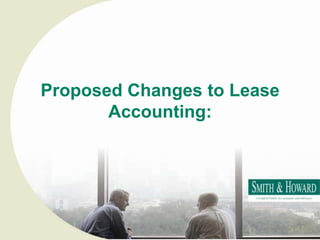
Proposed Changes To Lease Accounting
- 1. Proposed Changes to Lease Accounting:
- 2. Major Changes for Lessee’s: Almost all leases will be accounted under a method similar to how we currently account for capital leases Effectively eliminates all operating leases Expected exclusions: Leases with terms less than 12 months Immaterial Leases Leases for intangibles assets, leases to explore or use minerals, oil, or natural gas, and leases of biological assets.
- 3. Major Changes for Lessee’s (continued): A “right-of-use” asset will now be recorded on the balance sheet, representing the companies right to the leased asset over the term of the lease. A liability for the lease obligation will also be recorded on the balance sheet (INCLUDING expected renewal of options to extend). Both the “right-of-use” asset and the lease obligation liability are recorded at the present value of future lease payments based on the company’s incremental borrowing rate.
- 4. Subsequent periods: “Right-of-Use” Asset “Right-of-use” asset will be treated in a similar manner to fixed assets: The expected lease term will be the useful life used for amortization. “Right-of-use” assets as well as the related amortization expense will be separately identified in the financial statements Rent expense is essentially replaced by amortization expense.
- 5. Subsequent Periods:Lease Liability The lease liability is treated similarly to how we currently account for capital lease obligations. When lease payments are made, the payment is split between a reduction of the lease obligation liability and interest expense (just like a mortgage payment). The lease liability obligation will be separately identified on the balance sheet.
- 6. Basic Lease Example: Inception: 1/1/10 3 year lease $1,000 monthly payments 6.5% incremental borrowing rate: PV of Cash Flows: $32,627.49 Journal Entry: Right-of-Use Asset $ 32,627 Short-term lease liability 10,178 Long-term lease liability 22,449
- 10. Financial Statement Impact of New Rules: 12/31/2010
- 12. Changes for Lessors: Two accounting models for Lessors Performance obligation approach (MOST REAL ESTATE LEASES) If the lessor retains significant risk or benefits from the underlying assets, the lessor would retain the leased assets on the lessor’s books, record a receivable and a corresponding performance liability (i.e. deferred revenue). NOT a significant change to the current method used for lessor accounting. Derecognition approach If no significant risk or benefit is retained by the lessor, then the leased assets are removed from the books of the lessor, with the only remaining asset being a residual amount representing the rights to the asset at the end of the lease.
- 13. How Will This Impact Commercial Real Estate? Will companies shy away from long-term leases? Two reasons they shouldn’t 1 – Renewals options expected to be exercised are required to be included when booking initial liability. Company auditors will watch this closely. 2 – Economic substance of the transaction should still be the main driver…..not the accounting. If entering a long-term lease makes economic sense, that’s what should be done unless there are other factors to consider (i.e. bank covenants). Other Concerns?